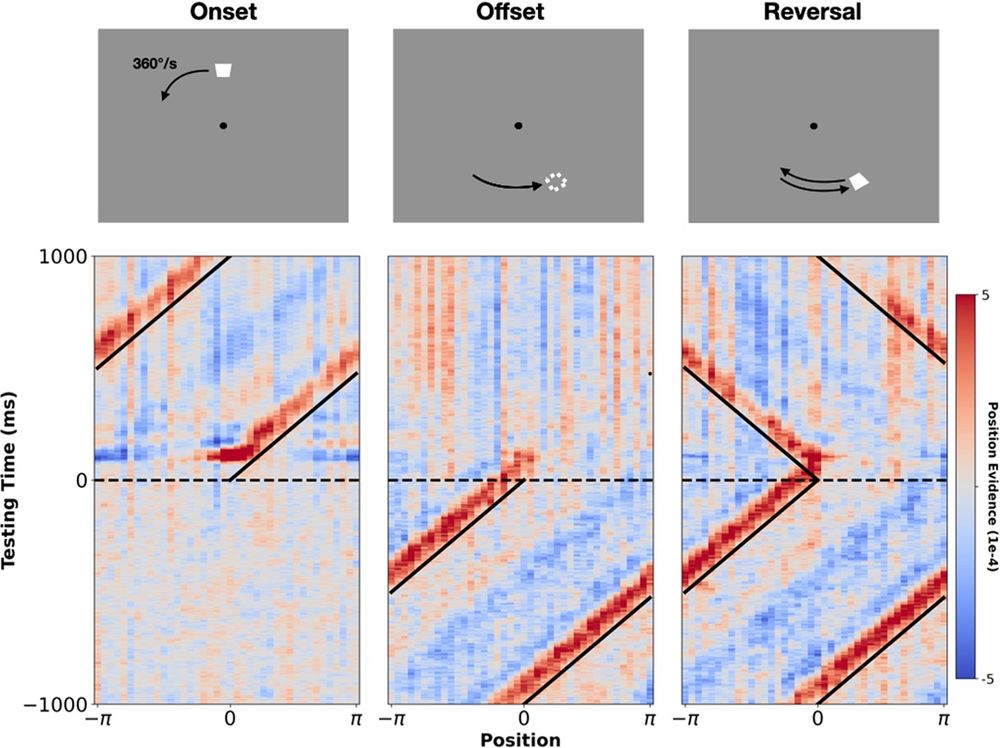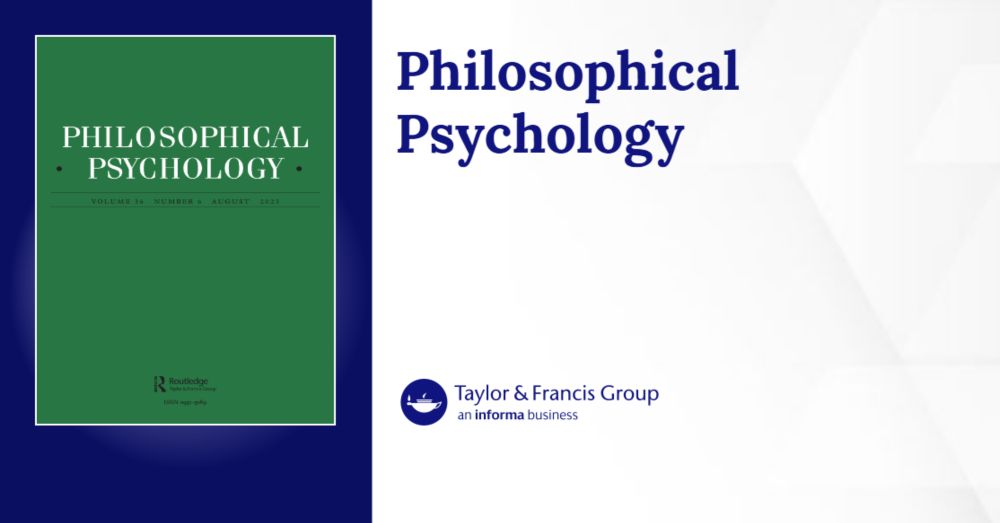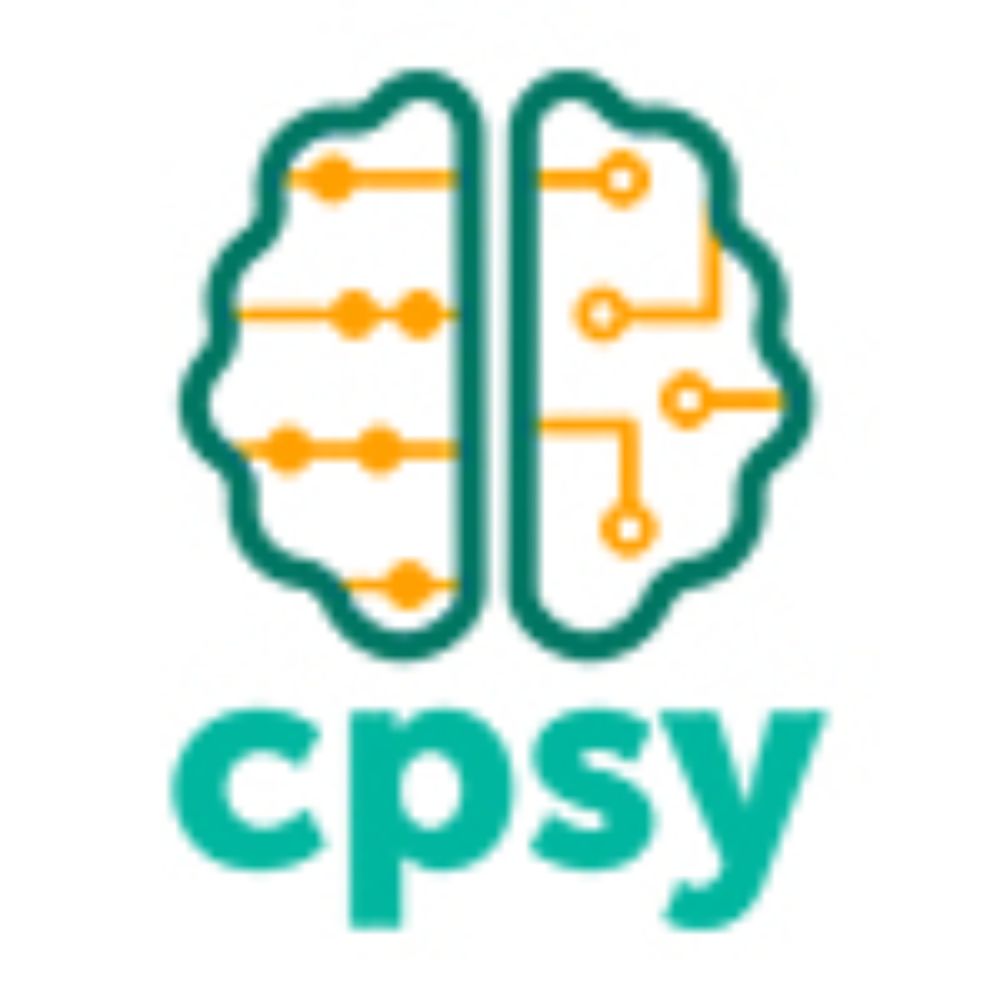
Mapping the position of moving stimuli. The top three panels show the three events of interest: stimulus onset, stimulus offset, and stimulus reversal (left to right). The bottom three panels show group-level probabilistic spatio-temporal maps centered around these three events. Diagonal black lines mark the true position of the stimulus. Horizontal dashed lines mark the time of the event of interest (stimulus onset, offset, or reversal). Red indicates high probability regions and blue indicates low probability regions (‘position evidence’ gives the difference between the posterior probability and chance). Note: these maps were generated from recordings at posterior/occipital sites.
It takes time for the #brain to process information, so how can we catch a flying ball? @renrutmailliw.bsky.social &co reveal a multi-stage #motion #extrapolation occurring in the #HumanBrain, shifting the represented position of moving objects closer to real time @plosbiology.org 🧪 plos.io/3Fm83Fc
27.05.2025 18:06 — 👍 19 🔁 5 💬 0 📌 0
Takeaways: musicians better in SJ tasks (but may be response bias) yet show > multisensory integration in a more objective RT task (but may be just better sustained attention, motivation, etc.). SJs show rapid recalibration but RTs don't, so RR probs not due to early sensory latency changes 9/10
19.03.2025 02:43 — 👍 2 🔁 1 💬 1 📌 0
APA PsycNet
⚠️New paper! If you like multisensory temporal perception, this one has HEAPS for you. We looked at simultaneity perception, simple RTs, race model inequality, serial dependence (recalibration), modality shift costs, musicians, and more! Findings summarised below 1/10
psycnet.apa.org/fulltext/202...
19.03.2025 02:43 — 👍 7 🔁 4 💬 3 📌 0
Ah, yes, that makes sense. An apt description, then. A lot of people also see the two dots as appearing semi-transparent (even in the conditions where they fully opaque, I mean), which might contribute to the effect you're describing.
03.02.2025 01:38 — 👍 1 🔁 0 💬 0 📌 0
Hmm... I'm not sure what you mean exactly. Are you saying the frames double too? The common reported experience is that only the dots "split", there is no illusory effects w/r/t the frames.
01.02.2025 02:08 — 👍 0 🔁 0 💬 1 📌 0
About 10-15% of people never saw the illusion in our experiment's viewing conditions so there may just be some intractable individual differences. I have always been very susceptible to this illusion so it's been hard to relate 😅
01.02.2025 02:06 — 👍 1 🔁 0 💬 0 📌 0
Most people report seeing two distinct dots either side-by-side or with some diagonality - typically with the dot on the left being lower and the right being higher. People also sometimes reported seeing "oblongs" or "rectangles" which we assumed to mean there was partial separation.
31.01.2025 03:40 — 👍 0 🔁 0 💬 1 📌 0
Just realised Bluesky supports videos so here is our new visual illusion!
Fix your gaze on the grey dot. How many red dots do you see within the green frames? Many people consistently see two, despite only ever being shown one!
jov.arvojournals.org/article.aspx... w/ @renrutmailliw.bsky.social
31.01.2025 00:02 — 👍 13 🔁 4 💬 1 📌 0
Thanks for saying! We played around with initial demo *a lot* to try and maximise the effect. We found lots of individual difference, but most see it inconsistently. It's an open question as to what produces the inconsistency. We posit something attentional although there's prob. multiple factors.
30.01.2025 23:55 — 👍 1 🔁 0 💬 0 📌 0
Hello Prof Miller. Bluesky didn't support uploading mp4 files when I originally posted, but it does now:
30.01.2025 23:54 — 👍 2 🔁 0 💬 2 📌 0
Thanks to Will and Hinze for being great supervisors, and to the rest of the Timing Lab for their support, particularly @tvcottier.bsky.social for helping set up the testing room itself and Ben Lowe for code troubleshooting #BenWasHere [5/5]
16.11.2024 11:37 — 👍 0 🔁 0 💬 0 📌 0
Thanks to Will and Hinze for being great supervisors, and to the rest of the Timing Lab for their support, particularly @tvcottier.bsky.social for helping set up the testing room itself and Ben Lowe for code troubleshooting #BenWasHere [5/5]
16.11.2024 02:15 — 👍 0 🔁 0 💬 0 📌 0
This illusion has a number of unique properties when compared to other motion illusions, but we also argue, using a predictive processing framework, that it has important implications for how the brain constructs visual experience in space and time more generally. [4/5]
16.11.2024 02:15 — 👍 1 🔁 0 💬 1 📌 0
In our illusion, we used two overlapping frames moving symmetrically and transparently. When a stimulus was flashed within the two frames as they both reversed direction, two concurrent mislocalisations can be perceived. [3/5]
16.11.2024 02:15 — 👍 0 🔁 0 💬 1 📌 0

Paradoxical stabilization of relative position in moving frames | PNAS
To capture where things are and what they are doing, the visual system may extract
the position and motion of each object relative to its surroundi...
The illusion was inspired by Özkan et al.'s (2021) paradoxical stabilisation of moving frames, where the position of a flashed stimulus is misperceived due to the motion signals from a surrounding frame as it reverses direction. [2/5] www.pnas.org/doi/10.1073/...
16.11.2024 02:15 — 👍 0 🔁 0 💬 1 📌 0
Concurrent perception of competing predictions: A “split-stimulus effect” | JOV | ARVO Journals
Excited to share my first paper: a novel visual illusion discovered by my co-authors Will Turner and Hinze Hogendoorn which we call the "Split-Stimulus Effect", in which a single flashed stimulus is perceived to be in two different locations simultaneously jov.arvojournals.org/article.aspx... [1/5]
16.11.2024 02:15 — 👍 47 🔁 15 💬 1 📌 2
In our illusion, we used two overlapping frames moving symmetrically and transparently. When a stimulus was flashed within the two frames as they both reversed direction, two concurrent mislocalisations can be perceived. [3/5]
16.11.2024 02:07 — 👍 0 🔁 0 💬 0 📌 0

Paradoxical stabilization of relative position in moving frames | PNAS
To capture where things are and what they are doing, the visual system may extract
the position and motion of each object relative to its surroundi...
The illusion was inspired by Özkan et al.'s (2021) paradoxical stabilisation of moving frames, where the position of a flashed stimulus is misperceived due to the motion signals from a surrounding frame as it reverses direction. www.pnas.org/doi/10.1073/... [2/5]
16.11.2024 02:07 — 👍 0 🔁 0 💬 1 📌 0
PhD Candidate at University of Melbourne. Computational neuroscience, memory, EEG, evidence accumulation models of decision making.
Professor of Computational Neuroscience and Psychiatry, Aarhus University. PI @ the Embodied Computation Group. We study perception, interoception, & metacogniton.
https://www.the-ecg.org
Hosting and publishing talks on philosophy since 1880.
http://www.aristoteliansociety.org.uk
Research Assistant @ PCD Lab, UNC-Chapel Hill studying perception and cognition
Philosopher of Science. The author of Thinking About Statistics (Routledge) and the Role of Mathematics in Evolutionary Theory (CUP).
https://junotk.net/
Professor of Cognitive Neuroscience at the FIL, UCL, using human neuroimaging to study how our prior knowledge influences the way we perceive the world. https://www.fil.ion.ucl.ac.uk/team/visual-perception-team/
Changing how the world thinks. Home to the big ideas and leading thinkers of our time. Subscribe here: https://iai.tv/subscribe
Host of HowTheLightGetsIn Festival 💡
Science-ing, trying to improve science. Cognitive and perceptual psychologist.
Biases include @simine (💍), cats (🚫)
Mastodon: @alexh@fediscience.org
A leading life science journal that champions high-impact research across all disciplines—from molecules to ecosystems. We offer innovative formats and collaborative editorial support to ensure your work achieves its full scientific impact.
The Association for the Scientific Study of Consciousness. Our next conference is: https://assc2025.gr/. Maintained by @mariandrnh.bsky.social
Theoretical Scientist | Researcher & Philosopher
Head of Research Department, RO Educational Institute
https://www.researchgate.net/profile/Jalal-Khawaldeh
https://orcid.org/0009-0003-7872-1967
Happy dad | Fascinated by perception | Anti-realist | Chair CCN2025 | #UvA #MidLevelVision #CognitiveAI
Australian Chapter of the Organisation for Human Brain Mapping (OHBM)
Deakin University's Neuroplasticity and Multimodal Imaging group 🧠
We are focused on using advanced imaging techniques to understand the neurobiological basis of cognitive and behavioural dysfunction
Warwickian. Kantian foremost
kritik.substack.com
We are a team of interdisciplinary researchers from two leading universities in Victoria, interested in the scientific study of consciousness.
https://www.mmcr.edu.au/
Psychology Lecturer at the University of Technology Sydney
morality psychology, computational modelling, belief updating, decision making, open science
(he)
scholar.google.com/citations?user=Juk4a9IAAA
Distinguished Professor Emerita of Philosophy, Rutgers University; Philosophy of Mind/Cognitive Science. Now living in south Texas
Associate Professor of #Philosophy at the University of Bergen. 🇳🇴 Various philosophical interests. Kant’s theoretical philosophy is my field of specialty. Other interests: arts, science, music, literature, photography, and travels.




